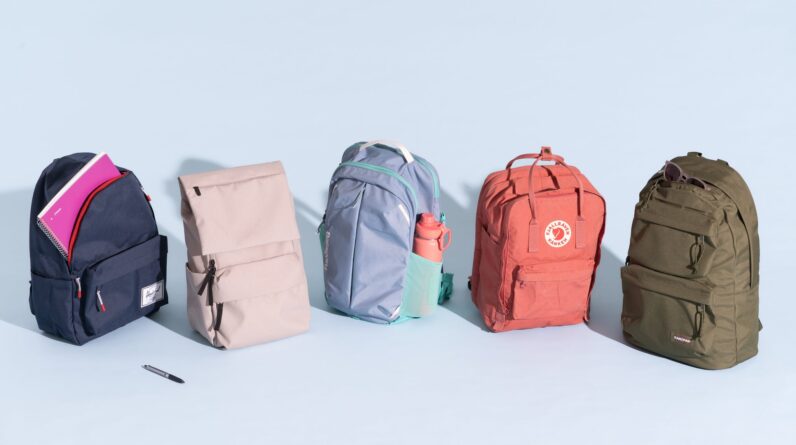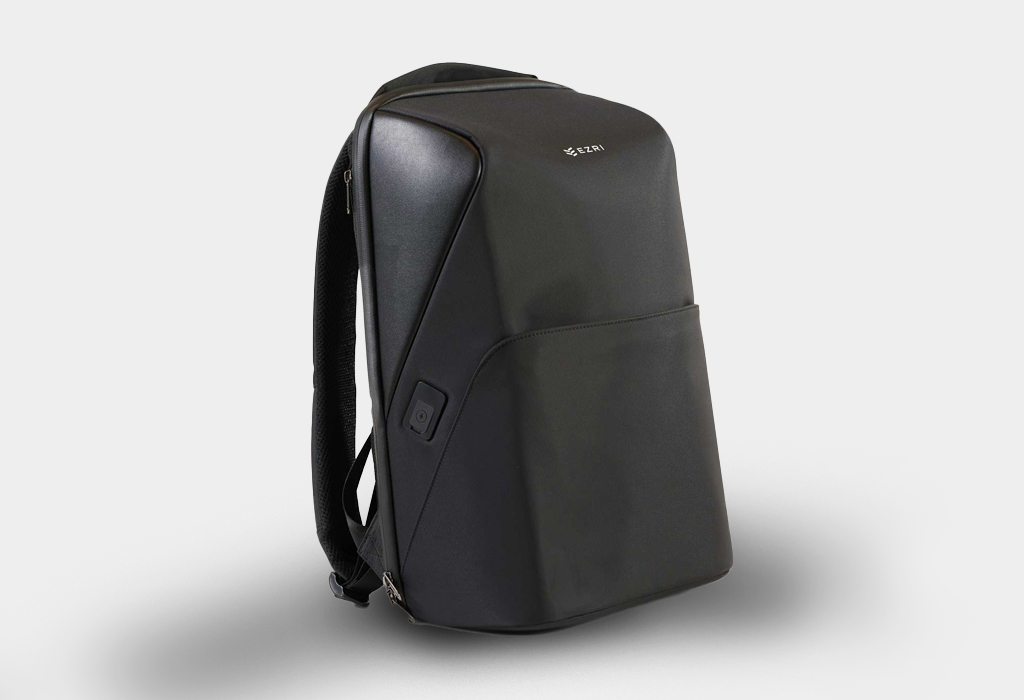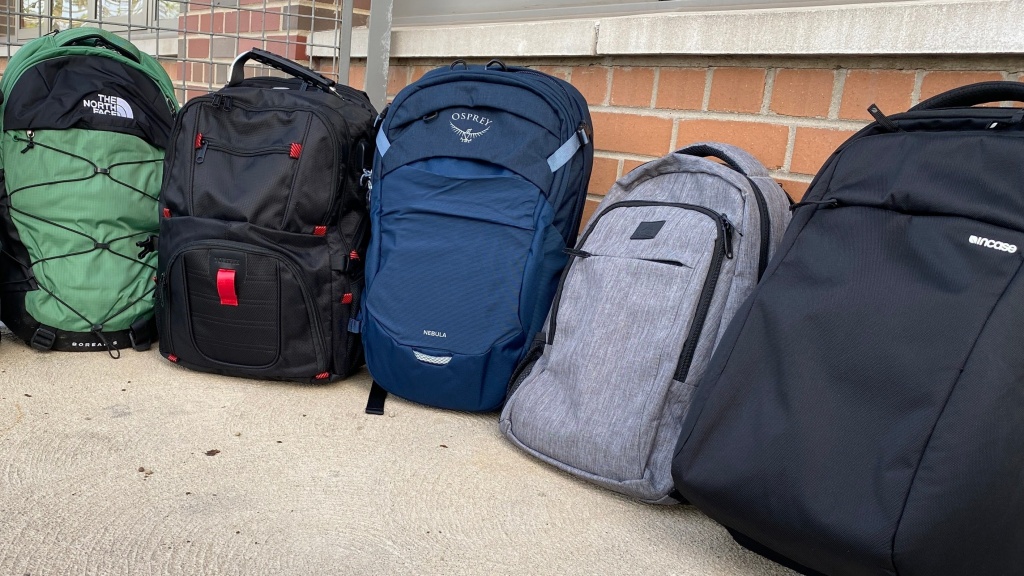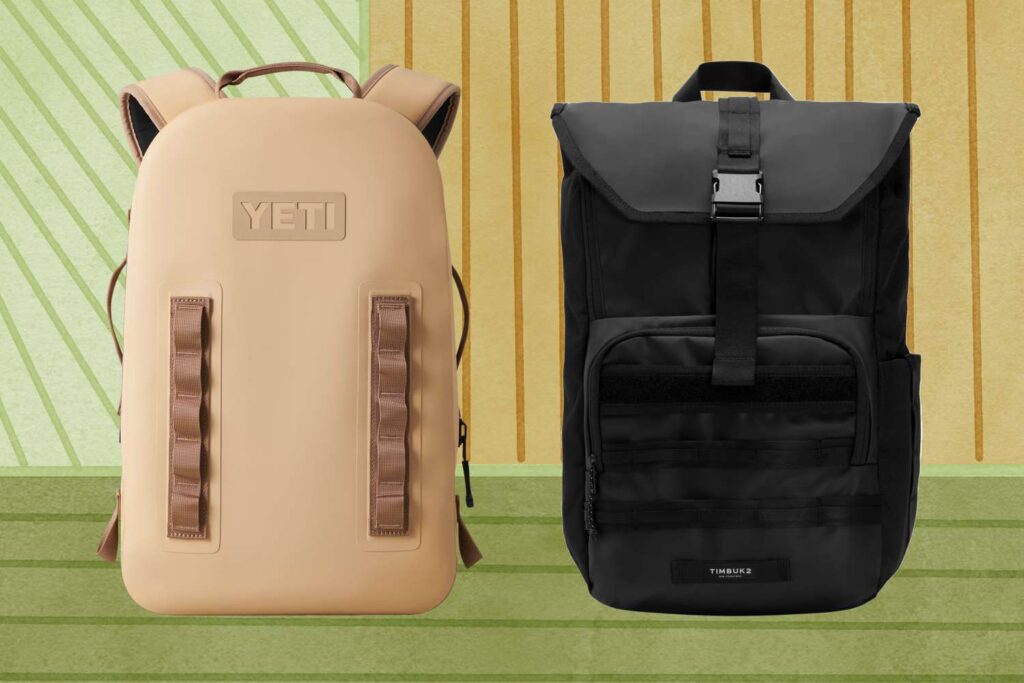
When it comes to selecting the perfect backpack, it’s crucial to consider the weather conditions. Whether you’re embarking on a summer hike or facing the winter snow, having the right material can make all the difference. In this article, we will explore the optimal material selection for backpacks in different weather, providing you with valuable insights to ensure your backpack withstands the elements and keeps your belongings safe and dry. Say goodbye to soggy belongings and hello to a backpack that’s suitable for any adventure, regardless of the forecast.

This image is property of www.realmenrealstyle.com.
Waterproof Materials
Polyester
Polyester is a popular choice for waterproof backpacks due to its excellent water resistance. It is a synthetic material that is known for its durability and resistance to tearing and abrasion. Polyester backpacks are typically coated with a water-resistant finish, which helps repel water and keep the contents of your backpack dry. This material is also lightweight, making it ideal for backpackers and hikers who need to carry their gear for long distances.
Nylon
Nylon is another commonly used material for waterproof backpacks. It is a synthetic fabric that is known for its strength and durability. Like polyester, nylon backpacks are often treated with a water-resistant coating to enhance their waterproof properties. Nylon backpacks are not only resistant to water but also to mold and mildew, making them a great choice for outdoor adventures in wet weather conditions.
Polyurethane-coated Fabrics
Polyurethane-coated fabrics are specifically designed to be highly waterproof. These fabrics have a polyurethane coating that forms a barrier against water, preventing it from penetrating the backpack. Polyurethane-coated fabrics are also lightweight and durable, making them a fantastic choice for backpackers who require a waterproof backpack that can withstand rugged outdoor conditions.
Vinyl
Vinyl is a popular material for waterproof backpacks due to its exceptional water resistance. It is a synthetic material that is known for its durability and low maintenance. Vinyl backpacks are typically made from PVC (polyvinyl chloride) or PU (polyurethane) coated fabrics, which provide excellent waterproofing capabilities. These backpacks are often used for water sports activities or in rainy climates where keeping your belongings dry is crucial.
Tarpaulin
Tarpaulin is a heavy-duty waterproof fabric that is commonly used in backpack construction. It is made from polyester or nylon that has been coated or laminated with PVC. Tarpaulin backpacks are incredibly durable and highly waterproof, making them an excellent choice for extreme weather conditions or for those who frequently travel in heavy rain or snow. The material can withstand significant wear and tear without compromising its waterproof properties.
Breathable Materials
Mesh
Mesh is a breathable material that is commonly used in the construction of backpacks, particularly in areas where airflow is crucial. Mesh panels and pockets allow air to circulate, preventing excessive sweating and discomfort. Backpacks with mesh back panels or shoulder straps are perfect for activities that require continuous movement and ventilation, such as hiking or running.
Cotton
Cotton is a natural fiber that is known for its breathability and comfort. While cotton is not inherently waterproof, it is highly absorbent and allows moisture to evaporate quickly, keeping you cool and dry. Cotton backpacks are ideal for casual use or in mild weather conditions where waterproofing is not a top priority but breathability and comfort are essential.
Canvas
Canvas is a heavy-duty, tightly woven fabric that offers both durability and breathability. It is commonly used in backpacks as it allows air to flow through, preventing excess heat build-up and providing a comfortable experience. Canvas backpacks are popular among campers and outdoor enthusiasts due to their ability to withstand rough usage and provide adequate ventilation.
Ventilated Fabrics
Ventilated fabrics are specifically designed to enhance breathability in backpacks. These materials often incorporate mesh panels, perforations, or micro-ventilation systems to promote air circulation and prevent moisture buildup. Ventilated backpacks are well-suited for activities that generate a lot of heat and sweat, such as biking or trekking in hot climates.
Air-permeable Fabrics
Air-permeable fabrics are designed to allow air to pass through the material while still providing protection against the elements. These fabrics are commonly used in backpacks to ensure breathability and ventilation, even in wet or humid conditions. Air-permeable backpacks are a great choice for outdoor activities where you need to balance waterproofing with airflow, such as kayaking or hiking in muggy environments.

This image is property of cdn.thewirecutter.com.
Insulating Materials
Neoprene
Neoprene is a synthetic rubber that is commonly used in insulating backpacks. It has excellent thermal properties, making it a great choice for keeping food, beverages, or sensitive electronics at a stable temperature. Neoprene backpacks are often used during outdoor activities such as camping or picnics, where maintaining the temperature of items is crucial.
Thermal Foams
Thermal foams, such as closed-cell foam or expanded polystyrene, are widely utilized for insulation in backpacks. These foams work by trapping air pockets, reducing heat transfer and keeping the contents of the backpack insulated. Thermal foam insulation is beneficial for backpacks intended for carrying temperature-sensitive items, such as medication or perishable goods.
Down
Down is a natural insulating material commonly used in backpacks, especially in cold weather or winter-specific backpacks. Down feathers provide excellent warmth-to-weight ratio, making them lightweight and highly effective at trapping body heat. Down insulation is commonly found in sleeping bags and winter backpacks where maintaining body temperature is crucial.
Synthetic Insulation
Synthetic insulation materials, such as PrimaLoft or Thinsulate, are widely used in backpacks as an alternative to down insulation. These materials are designed to mimic the insulating properties of down while being more resistant to moisture and retaining warmth even when wet. Synthetic insulation is a preferred choice for backpacks that may be exposed to damp or humid conditions.
Lightweight Materials
Ripstop Nylon
Ripstop nylon is a lightweight and highly durable material that is frequently used in backpacks where weight is a significant consideration. It is made by weaving thick reinforcement threads into the fabric, which helps prevent tears or rips from spreading. Ripstop nylon is commonly used in ultralight backpacks or backpacks designed for fast-paced activities such as trail running or mountain biking.
Cuben Fiber
Cuben Fiber, now known as Dyneema Composite Fabric (DCF), is an ultra-lightweight and incredibly strong material commonly used in high-end backpacks. It is made from laminated layers of high-strength fibers, resulting in a fabric that is resistant to tears, punctures, and water. Cuben Fiber backpacks are perfect for adventurers who prioritize minimizing weight without compromising durability.
Silnylon
Silnylon, short for silicone nylon, is a popular lightweight material used in backpacks due to its excellent packability and water repellency. It is made by applying a silicone coating to a nylon fabric, which enhances its strength, tear resistance, and waterproof properties. Silnylon backpacks are often used in backpacking or travel where weight and water protection are essential factors.
Spinnaker Fabrics
Spinnaker fabrics are lightweight and highly durable materials that are originally used in sailing and parachutes. They are made from a range of synthetic fibers, such as nylon or polyester, and are designed to be both lightweight and weather-resistant. Spinnaker fabric backpacks are well-suited for outdoor activities that require a balance between weight and durability, such as hiking or mountaineering.
Cordura
Cordura is a durable and lightweight fabric that is known for its resistance to abrasion and tear. It is made from high-tenacity nylon or polyester fibers, which contribute to its exceptional strength. Cordura backpacks are commonly used in rugged outdoor environments where durability and lightweight performance are crucial, such as backpacking or rock climbing.

This image is property of hips.hearstapps.com.
Durable Materials
Ballistic Nylon
Ballistic nylon is a heavy-duty fabric that is designed to withstand extreme wear and tear. It was originally developed for military applications, making it exceptionally durable and resistant to abrasion. Ballistic nylon backpacks are ideal for activities that involve rough handling or exposure to harsh conditions, such as adventure travel or backpacking in rugged terrains.
Leather
Leather is a classic and timeless material known for its exceptional durability and strength. Leather backpacks are favored for their ability to withstand heavy loads and rugged use over time. While leather may not be inherently waterproof, it can be treated with a protective coating to enhance its resistance to water. Leather backpacks are often used for both urban and outdoor purposes, providing a stylish yet durable option.
Polyester Canvas
Polyester canvas is a variant of canvas that combines the strength and durability of polyester with the breathability and natural aesthetics of canvas. It is frequently used in backpacks due to its resistance to abrasion and tear. Polyester canvas backpacks are suitable for various activities, including hiking, camping, or everyday use, where durability and style are desired.
Hypalon
Hypalon is a synthetic rubber material that is highly resistant to chemicals, extreme temperatures, and UV rays. It is commonly used in backpacks that require excellent durability and resistance to environmental conditions. Hypalon backpacks are often seen in water sports or outdoor pursuits where exposure to sun, water, or harsh chemicals is common.
Kevlar
Kevlar is a high-strength synthetic fiber known for its exceptional toughness and resistance to cuts and punctures. It is commonly used in ballistic armor and protective gear due to its ability to withstand high impact forces. Kevlar backpacks are incredibly durable and provide a high level of protection to the contents within, making them ideal for extreme outdoor adventures or professions that require rugged gear.
UV-resistant Materials
Polyester
Polyester is a versatile material that offers excellent UV resistance. It is often treated with UV inhibitors or coated with sun-protective finishes to enhance its ability to block harmful UV rays. Polyester backpacks with UV-resistant properties are highly recommended for activities that involve prolonged sun exposure, such as hiking, camping, or beach trips.
Nylon
Nylon is another material that provides good UV resistance. It naturally absorbs UV radiation, helping to protect the backpack and its contents from sun damage. Nylon backpacks with UV-resistant coatings or finishes are ideal for outdoor activities where sun protection is essential, such as mountaineering or long-distance hiking.
Polyethylene
Polyethylene is a thermoplastic polymer that offers excellent UV resistance. It is commonly used in backpacks that are intended for prolonged exposure to sunlight, such as beach backpacks or backpacks used in outdoor sports. Polyethylene backpacks provide reliable protection against the damaging effects of UV radiation, ensuring that your gear and belongings remain intact.
Oxford Fabric
Oxford fabric is a tightly woven material that is known for its durability and UV resistance. It is commonly used in backpacks due to its strength and ability to withstand harsh weather conditions. Oxford fabric backpacks are often preferred for outdoor activities where exposure to the sun is high, such as hiking or mountaineering.
Coated Fabrics
Coated fabrics, such as PVC or PU-coated nylon or polyester, are commonly used in backpacks to provide UV resistance. The coating on these fabrics acts as a protective layer against UV rays, preventing them from penetrating the backpack and causing damage or fading. Coated fabric backpacks are suitable for any outdoor activity that involves sun exposure.

This image is property of u7q2x7c9.stackpathcdn.com.
Quick-drying Materials
Polyester
Polyester is a quick-drying material that is widely used in backpacks. It has low water absorption and dries relatively quickly when wet, making it a practical choice for backpacks that may be exposed to rain or water. Polyester backpacks are perfect for outdoor activities where staying dry is essential, such as hiking, trekking, or water sports.
Nylon
Nylon backpacks also offer quick-drying capabilities, thanks to their low water absorption properties. Nylon fabrics dry rapidly and are often used in backpacks designed for water-related activities or in areas with high humidity levels. Nylon backpacks are resilient and can withstand exposure to water, ensuring that your gear remains dry and comfortable.
Microfiber
Microfiber refers to ultra-fine synthetic fibers that are tightly woven into a fabric. This material has excellent wicking properties, allowing it to absorb and evaporate moisture quickly. Microfiber backpacks are highly suitable for activities that involve intense physical exertion or excessive sweating, as they help keep your belongings dry and your body comfortable.
Water-repellent Fabrics
Water-repellent fabrics are designed to shed water, keeping your backpack and its contents dry. While they may not be completely waterproof, these fabrics provide a level of protection against light rain or splashes. Water-repellent backpacks are ideal for everyday use or urban commuting, where encounters with rain or water are common but not prolonged.
Synthetic Fabrics
Various synthetic fabrics, such as polyester or nylon blends, are often engineered to be quick-drying. These fabrics are designed to wick moisture away from the skin and into the outer layers, where it can evaporate rapidly. Backpacks made from synthetic quick-drying fabrics are widely used by athletes, travelers, and outdoor enthusiasts who require gear that dries quickly and efficiently.
Flexible Materials
Polyester
Polyester is a highly flexible material that is commonly used in backpack construction. It can be easily manipulated and shaped without losing its structural integrity, making it a popular choice for creating backpack designs that require flexibility and versatility. Polyester backpacks are ideal for activities that involve constant movement or changes in load, such as hiking or traveling.
Spandex
Spandex, also known as Lycra or Elastane, is a stretchable synthetic fiber that is often blended with other materials to increase flexibility and stretchability. Spandex enables backpacks to conform to your body’s movements, providing a comfortable and snug fit. Backpacks with spandex components are commonly used in activities that require agility or a wide range of motion, such as cycling or running.
Lycra
Lycra, a type of spandex, is renowned for its incredible elasticity and shape retention. It is commonly used in backpacks to provide comfort and flexibility, ensuring that the backpack molds to your body and moves with you. Lycra backpacks are particularly popular among athletes or fitness enthusiasts who require freedom of movement without compromising on carrying capacity.
Polyurethane
Polyurethane, often used as a coating or film, is a flexible material that is added to backpacks to enhance their flexibility and durability. It allows the backpack to withstand bending, stretching, or compression without tearing or losing shape. Polyurethane backpacks are highly versatile and are suitable for a wide range of activities, from hiking and camping to everyday use.
Elastane
Elastane, also known as Spandex, is a synthetic fiber known for its stretchability and shape retention. It is often incorporated into backpacks to provide flexibility and ensure a snug fit. Elastane backpacks are commonly used in sports or outdoor activities that require flexibility and comfort, such as rock climbing or trail running.

This image is property of www.travelandleisure.com.
Abrasion-resistant Materials
Cordura
Cordura is a highly abrasion-resistant material commonly used in backpacks. It is made from nylon or polyester fibers that have been coated or treated to enhance their resistance to tearing, scuffing, or wear. Cordura backpacks are favored by backpackers, hikers, and travelers who require gear that can withstand rugged conditions and heavy use.
Kevlar
Kevlar is an extremely durable and abrasion-resistant material that is often used in high-performance backpacks. It is a synthetic fiber known for its strength and resistance to cuts, punctures, and impact. Kevlar backpacks are popular among outdoor enthusiasts who engage in extreme activities or require robust gear that can withstand harsh environments.
Polyester
Polyester backpacks are often reinforced with additional layers or coatings to increase their resistance to abrasion. Polyester itself is a strong and durable material, making it well-suited for outdoor use. Polyester backpacks with added abrasion resistance are ideal for activities that involve contact with rough surfaces or prolonged wear and tear.
Canvas
Canvas is a durable material that offers excellent resistance to abrasion and wear. It is commonly used in backpacks, particularly in rugged outdoor backpacks, as it can withstand frequent use and exposure to rough terrain. Canvas backpacks are ideal for activities such as hiking or camping, where durability and longevity are essential.
Leather
Leather backpacks are naturally resistant to abrasion and have a proven track record of durability. The thickness and quality of leather make it highly resistant to scratches and tears, ensuring that your backpack remains intact for years to come. Leather backpacks are often chosen by those seeking a combination of style, functionality, and exceptional durability.
Strong Seams and Stitching
Bar-tack Stitching
Bar-tack stitching is a reinforcing technique that involves stitching a tight, dense zigzag pattern at stress points or areas prone to heavy tension. This stitching method distributes stress evenly, preventing the fabric or seams from fraying or tearing. Bar-tack stitching is commonly used in backpacks along strap attachments, handles, or areas that bear significant weight to reinforce the backpack’s strength.
Box Stitching
Box stitching is a technique used to reinforce stress points or areas that require extra strength. It involves creating a box-shaped stitching pattern by sewing several parallel stitches, forming a square or rectangular shape. The additional stitching provides increased stability and prevents the fabric from tearing or unraveling. Box stitching is often used in backpacks for attaching straps, buckles, or load-bearing areas.
Bartack Reinforcement
Bartack reinforcement is a specific type of stitching used at critical attachment points on backpacks. It involves sewing a dense, tight cluster of stitches in a small rectangular or square shape. Bartack stitching reinforces areas prone to heavy stress or tension, such as where shoulder straps or compression straps connect to the backpack. This stitching technique ensures exceptional strength and prevents fabric or seams from failing.
Triple Stitching
Triple stitching involves sewing three parallel lines of stitches side by side to provide extra strength and stability. This technique is commonly used in backpacks where durability and load-bearing capacity are essential. Triple stitching reinforces seams, belts, or straps, making them highly resistant to tearing or separation. Backpacks with triple stitching are built to withstand heavy loads and rough handling.
When it comes to choosing the right material for a backpack based on weather conditions, it’s essential to consider various factors such as waterproofing, breathability, insulation, weight, durability, UV resistance, quick-drying capabilities, flexibility, abrasion resistance, and strong seams. By understanding the properties and characteristics of different materials, you can select a backpack that suits your needs and performs well in specific weather conditions. Whether you’re embarking on a hiking adventure, traveling, or simply commuting, the right backpack material can greatly enhance your overall experience and ensure the protection of your belongings.





